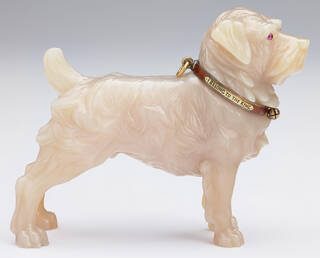One of the most significant carvings undertaken by Fabergé as part of the Sandringham commission was that of King Edward VII's favourite dog Cæsar, a Norfolk terrier. The King and Cæsar adored each other and were inseparable.
Following The King's death in May 1910, Cæsar was inconsolable and roamed the corridors of Buckingham Palace looking for his master. He even attended the King's funeral, walking behind the carriage that held the coffin, alongside a Highland soldier – the sight of which endeared him to the nation.

A sentimental book published in June 1910 called Where’s Master? and supposedly written by Cæsar himself, sold over 100,000 copies. The little dog's relationship with The King is acknowledged on Edward VII's tomb in St. George's Chapel Windsor, where he is represented eternally curled up at The King's feet.
The small Fabergé figure of Cæsar, measuring 5.1 x 6.5 x 2.2cm, is carved in white chalcedony with ruby eyes and an enamel and gold collar which carries the inscription: 'I belong to the King' – exactly as it did in real life. The carving was bought by the Hon. Mrs. Greville on 29 November 1910 for £35, and given to the King's widow, Queen Alexandra, as a gift for her birthday.
Open the viewer below to read Where’s Master? By Cæsar The King's Dog.
Find out more about Fabergé's Sandringham commission.
